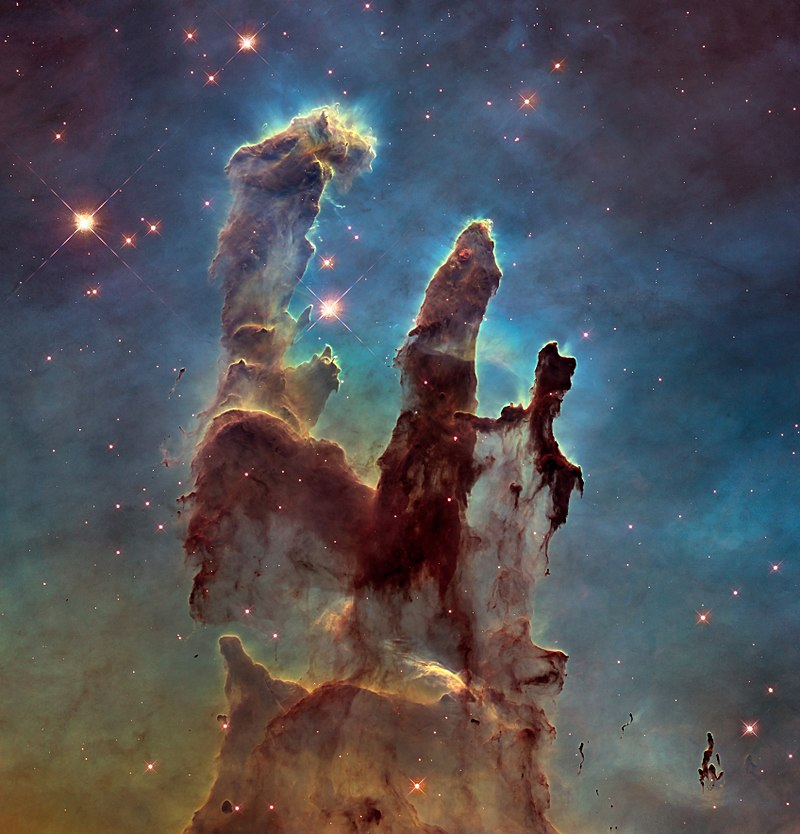Two ways of gazing at the stars
An astrophysicist and a poet discover they have much in common
Rebecca Sohn • October 17, 2019

The Eagle Nebula, in a photograph from NASA. Science and poetry both “try to push back the boundary of what is understood yet,” says poet Katharine Coles. [Credit: NASA, the European Space Agency, and the Hubble Heritage Team via Wikimedia | Public Domain]
On the banks of the Hudson River, in a library of over 70,000 books of poetry, a rapt audience gazed at the birth of the very first star in the universe.
Of course, this wasn’t a real star, but a computer simulation. Astrophysicist Mordecai-Mark Mac Low, a curator at the American Museum of Natural History, was demonstrating the type of simulation that underpins his astronomical research.
Seated beside him, poet Mei-Mei Berssenbrugge was ready with her own vision of the stars — a new poem titled “Wonders in Five Parts,” which is largely a meditation on stargazing. “My awe is like blindness,” she recited, “wonder exchanges for sight.”
Their mutual attempts to convey the mysteries of the cosmos was the purpose of the Oct. 5 gathering at Poets House in Battery Park City, the first of a series of events focused on poetry and science.
Both poets and scientists grapple with concepts that are difficult to understand in the traditional sense, which is why they both often reach for metaphors that, while not always true, confer understanding. For instance, “stars aren’t born, nor do they die,” noted the event’s moderator Katharine Coles, in her introduction. Coles, a poet from Salt Lake City, is a current poet-in-residence for Poets House’s Field Work initiative.
“We’re working in Salt Lake City and Milwaukee to bring together libraries and natural history museums,” said Poets House director Lee Briccetti, “very specifically exploring ways that STEM learning and literature can reinforce each other.”
Coles, Berssenbrugge and Mac Low all agreed that in astronomy even concepts that aren’t exact can be valuable. Mac Low’s computer simulations model and test hypotheses about the formation of the universe, but the simulations invariably have components — such as dark matter, completely undetectable material that many physicists believe comprises the vast majority of matter in the universe — that are not well understood.
Just being able to perceive something, even if you cannot know its every component, is helpful, Berssenbrugge argued. “Perception is completely malleable,” she said. “Reality is a learning curve.”
That is also a great representation of science, according to Mac Low. “Success of approximation tells us something about reality,” he said, referring to the computer simulations that are the backbone of his research, “but it’s still not reality.”
Still, there are fundamental differences between the way scientists and poets see the world. Poets allow much more room for subjectivity, sometimes stretching scientific knowledge to the breaking point.
During the event, for instance, there was some tension when Berssenbrugge seemed to misrepresent the scientific theory of quantum entanglement. She wanted to use this theory of the connections between subatomic particles to connect human life to the stars. Mac Low offered a quick correction, pointing out that the principle isn’t that simple.
Quantum entanglement is a complex theory about how particles that once directly interacted can retain corresponding properties over distances, but not, he said, over distances as vast as the entire universe. In response, Berssenbugge asked if it was true that there was a wave function that described the entire universe, as she had heard. Mac Low clarified that while there was such a function, it was very imprecise and possibly inaccurate at such a scale.
Poets, to be sure, have a much broader tolerance for imprecision than scientists. Berssenbrugge, who lives in New Mexico, said she’s just as interested in indigenous views of the cosmos as she is in prevailing scientific ideas that are based on testable observations. Such non-empirical knowledge may not strictly be science, but lies well within the domain of poetry, and can inspire wonder as surely as a quantum equation.
It is the human capacity to both wonder and seek answers that ultimately unites these two very different ways of seeing the universe, the poet and the astrophysicist agreed. “I wonder what could happen if…,” said Mac Low, is the foundation of both his cosmic simulations and of science itself.
Berssenbrugge felt the same, describing wonder as a kind of “interior physics” that can guide her in new creative directions. Like Mac Low, she said that she is always listening to her sense of wonder, trying to discover where it might lead her next.
1 Comment
Science vs Poetry :
Polish poet Juliusz Słowacki [1809-1849] wrote between 1843/4-1846? a mystical prose poem entitled “Genesis from the Spirit” published in 1871. If we reduce the mystical parts of the poem to a minimum and leave only the purely « objective » parts, we arrive at his poetic description of the “Big Bang” :
“…The Spirit… turned one point… of invisible space into a flash of Magnetic-Attractive Forces. And these turned into electric and lightning bolds – And they warmed up in the Spirit… You, Lord, forced him… to flash with destructive fire… You turned the Spirit… into a ball of fire and hung him on the abysses… And here… a circle spirits… he grabbed one handful of globes and swirled them around like a fiery rainbow… “
This is how poetic intuition could anticipate the scientific discoveries…
(see :
https://www.salon24.pl/u/edalward/1334289,big-bang-according-to-the-19th-century-polish-poet-j-slowacki )